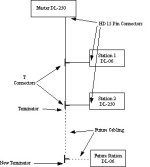zmanvortex
Member
Hi everyone. I am attempting to set up a DirectNet RS-422 multidrop network. I will be using an AutomationDirect DL-250 port 2 as the network master and up to 8 slaves consisting of a mixture of DL-06's and DL-240 processors depending upon the customer's specs. I understand how the master/slave network and instructions work. I also know how to make the cable. What I am looking for is a way for our installers to add another station (slave) and be able to just plug in another cable off of the last slave and move a terminator connector to the most recently added slave. I am looking for something similar to what Allen-Bradley did with DeviceNet cabling where you just screw on another cable from the device into a T or Y connector on the network cable.



